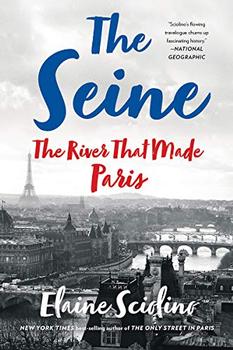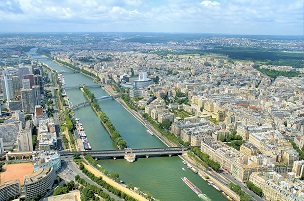Summary | Excerpt | Reading Guide | Reviews | Beyond the Book | Read-Alikes | Genres & Themes | Author Bio

The River that Made Paris
by Elaine SciolinoThis article relates to The Seine
 In her fifth book, The Seine: The River that Made Paris, New York Times foreign correspondent Elaine Sciolino explores the history of one of the world's most famous rivers and its impact on the capital of France.
In her fifth book, The Seine: The River that Made Paris, New York Times foreign correspondent Elaine Sciolino explores the history of one of the world's most famous rivers and its impact on the capital of France.
The 777-kilometer-long (483 mi) river runs from its source near Dijon in northeastern France, through Paris, toward its estuary in the English Channel (known to the French as La Manche, "The Sleeve"). It can be divided into five distinct parts: the Petite Seine ("Small Seine"), from the source in Burgundy to Montereau-Fault-Yonne; the Haute Seine ("Upper Seine"), from Montereau-Fault-Yonne to Paris; the Traversée de Paris ("Paris waterway"); the Basse Seine ("Lower Seine"), from Paris to Rouen; and the Seine Maritime ("Maritime Seine"), from Rouen to the sea. It passes through cities such as Troyes, Melun, Corbeil, Mantes, Rouen and, of course, Paris.
The Seine is the second longest river in France, bested only by the Loire, with a length of 1,012 kilometers (629 mi). Its waters are slow flowing and easily navigable, and its course is serpentine and full of bends with a depth of about 9.5 meters (31 ft). It is a major commercial waterway and trading route; canals link it to the Loire, as well as the Rhine and the Rhone.
As Sciolino makes clear, the river is intimately associated with the culture of Paris. It divides the city into two distinct halves: the Left Bank (Rive Gauche) and the Right Bank (Rive Droite). Thirty-seven bridges, including four footbridges, cross the Seine within Paris. For nearly two kilometers (1.24 miles), the river is bordered on both sides by double-decker quays, the "quais hauts" (high quays) and "berges" (low quays). On the quays, people picnic and promenade; tourists visiting Paris will find no shortage of activities along the riverside.
The Seine is far more than just an ideal spot for recreation. While many once called the Seine "an open sewer," as scholar Michael Hogan has highlighted, its water quality has skyrocketed in recent decades. Over half of Paris's water supply is drawn from it, and industry depends upon it to transport goods.
Over the years many artists have paid tribute to the Seine. From Auguste Renoir to Albert Lebourg, painters have sketched vivid portraits of the river's banks. Claude Monet's paintings are especially well known and highly regarded. He often used the river's reflections to create a distinctive mirror effect in his paintings, which revealed both the heights of the sky and the depths of the water.
Those interested in learning more about the Seine would do well to check out Sciolino's riveting history of the famous river. The author's previous book, The Only Street in Paris: Life on the Rue des Martyrs, makes an excellent companion volume.
Filed under Nature and the Environment
![]() This "beyond the book article" relates to The Seine. It originally ran in October 2019 and has been updated for the
October 2020 paperback edition.
Go to magazine.
This "beyond the book article" relates to The Seine. It originally ran in October 2019 and has been updated for the
October 2020 paperback edition.
Go to magazine.
All my major works have been written in prison...
Click Here to find out who said this, as well as discovering other famous literary quotes!
Your guide toexceptional books
BookBrowse seeks out and recommends the best in contemporary fiction and nonfiction—books that not only engage and entertain but also deepen our understanding of ourselves and the world around us.